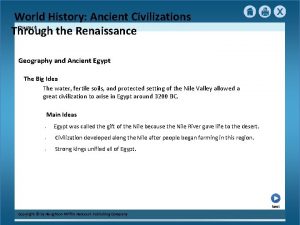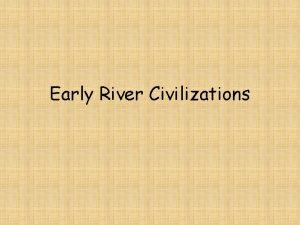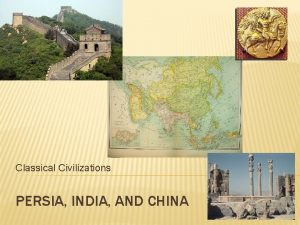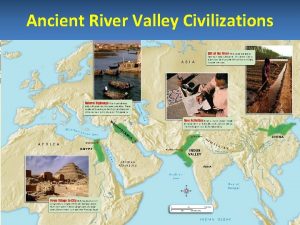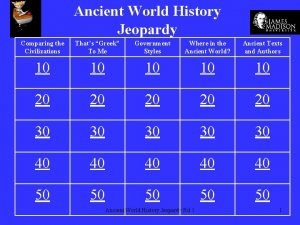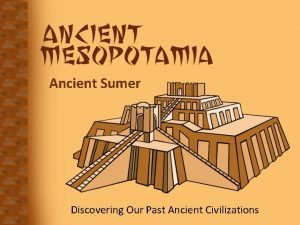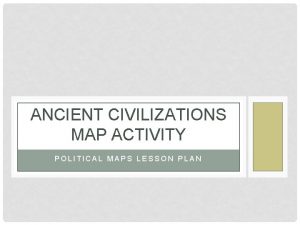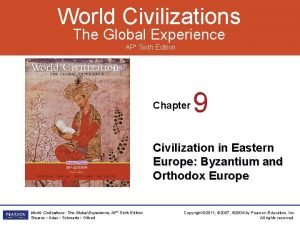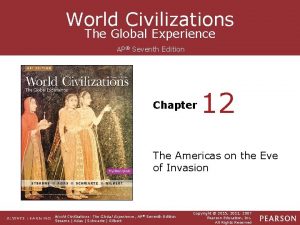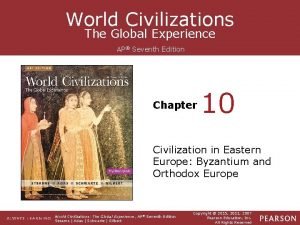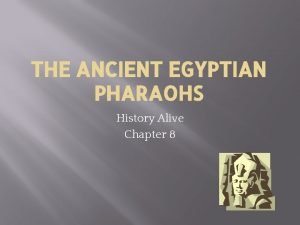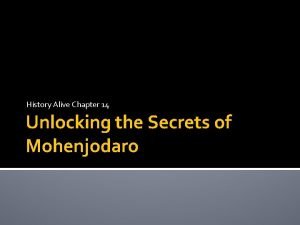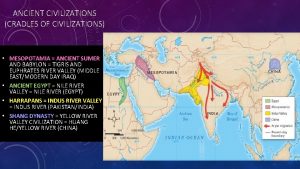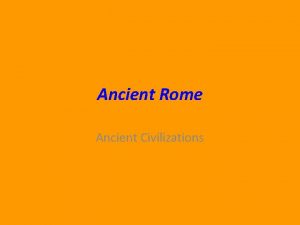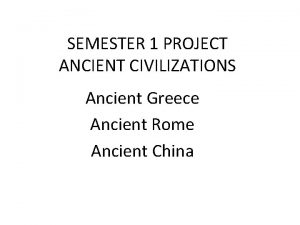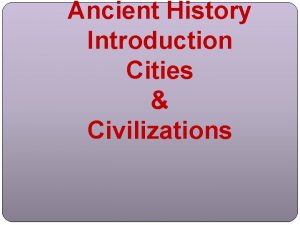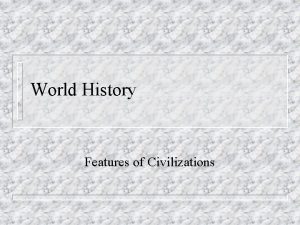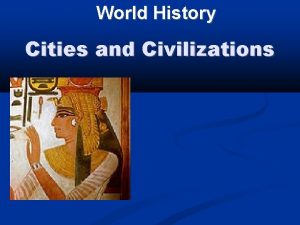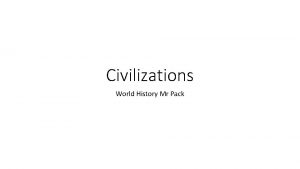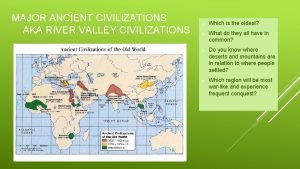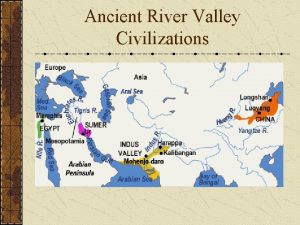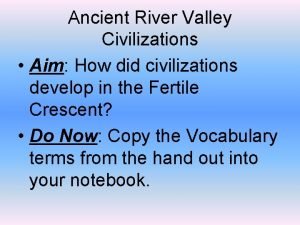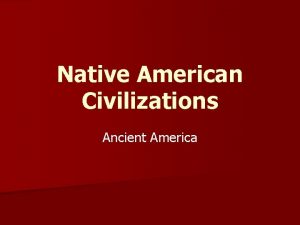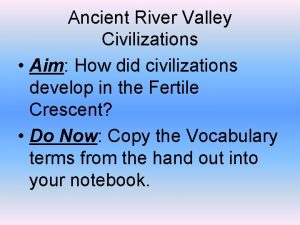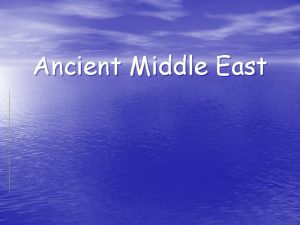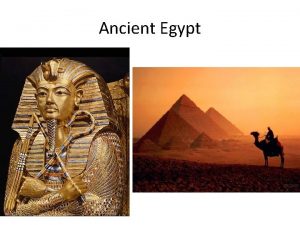World History Standard One ANCIENT CIVILIZATIONS History Class
























- Slides: 24

World History Standard One ANCIENT CIVILIZATIONS

History Class DO NOW: On a piece of paper write a paragraph about what you know about ancient civilizations. Do you remember any names? Where were they located? What was special about them? Next, write what would you like to know about ancient civilizations? You have 5 min!

SSWH 1 The student will analyze the origins, structures, and interactions of complex societies in the ancient Eastern Mediterranean from 3500 BCE to 500 BCE. a. Describe the development of Mesopotamian societies; include the religious, cultural, economic, and political facets of society, with attention to Hammurabi’s law code. b. Describe the relationship of religion and political authority in Ancient Egypt. c. Explain the development of monotheism; include the concepts developed by the ancient Hebrews, and Zoroastrianism. d. Describe early trading networks in the Eastern Mediterranean; include the impact Phoenicians had on the Mediterranean World. e. Explain the development and importance of writing; include cuneiform, hieroglyphics, and the Phoenician alphabet.

Land between rivers Tigris and Euphrates.

Mesopotamia: Cradle of Civilization Mesopotamia means "the land between the rivers" or "the land between the two rivers. " This was the site of the world's first civilization, Sumer. CRADLE OF CIVILIZATION Mesopotamia is often referred to as the "cradle of civilization" because the world's first civilization occurred there.

Mesopotamia – Home of Many different groups of people lived in Mesopotamia. Some of them were: Sumerians, Akkadian, Assyrians, Babylonians and later Arameans and Chaldeans. This was a region encompassing modern Iraq, Kuwait, southeast Turkey and northeast Syria.

The Hanging Gardens According to legend, 6 th-century Babylonian King Nebuchadnezzar had a colossal maze of waterfalls and dense vegetation planted across his palace for a wife, who missed her lush homeland. Archaeologists still debate the garden's existence. Credit: Photo Credit: A 16 th century depiction of the Hanging Gardens of Babylon (by Martin Heemskerck)

Sumer was the world's first civilization. It was located in the southern area of Mesopotamia where the twin rivers converged. The people who lived in this area were called Sumerians.

Religion in Mesopotamians believed in many gods. This type of religion is called Polytheism worshipping over 2, 100 supernatural beings. Compared with Christianity that worships one god. The gods are a window into the value system of the Mesopotamians--they valued fertility, sought protection in war, respected wisdom, and they clearly had a reverence for the earth. According to Mesopotamian mythology, human beings were created so the gods would have servants. One Babylonian creation myth states it like this. . . "Man shall be charged with the service of the gods, that they might be at ease. "

Ziggurat in Sumer The ziggurat was a temple. It was located in the center of each Sumerian city-state. It housed the city-state's patron god. The term ziggurat means "mountain of god" or "hill of heaven. " Since the ziggurat was a sacred place, only priests could enter it. It was a rectangular stepped tower.

Culture in Mesopotamia Remember, this is a culture of many peoples. But in general they all had similarities. In order to control the destructive seasonal flooding of the Tigris and Euphrates Rivers, the ancient Sumerians constructed levees, or raised areas of earth, in order to hold back the floodwaters. The ancient Sumerians irrigated, or watered, their crops by using a system of irrigation canals. By devising such a irrigation system, the ancient Sumerians were able to successfully establish a permanent civilization.

Cuneiform Writing The ancient Sumerians created the world's first writing system known as cuneiform. The term cuneiform means "wedge-shaped. " Sumerian writing is wedge-shaped because of the type of instrument that was used to create it. The ancient Sumerians used a stylus to write. A stylus is a wedge-shaped instrument made out of reed. The Sumerians wrote on wet clay tablets with a stylus. An edubba is a Sumerian school where young boys learned reading, writing, and arithmetic. After graduating from a Sumerian school, a young man became a scribe, or a writer.

Economy in Mesopotamia Trade and commerce developed in Mesopotamia because the farmers learned how to irrigate their land. They could now grow more food than they could eat. They used the surplus to trade for goods and services. Ur, a city-state in Sumer, was a major center for commerce and trade. Temples were the chief employer and location for commercial activity. The system of trade developed from people's need. People in the mountains needed wheat and barley. Mountain people could give timber, limestone, gold, silver, and copper. Flax was grown in the river valley and then woven into cloth. Linen garments were worn by priests and holy men. Wool and wool cloth was also important for trade. Wood was used for ships and furniture. Various crafts developed: pottery, cloth-making, brick-making etc.

Barter System The Mesopotamians used the barter system instead. They developed a writing system to keep track of buying and selling. Scribes kept accurate records of business transactions by writing on clay tablets. Business contracts were sealed with a cylinder wheel.

Government of Mesopotamia The ancient Sumerians organized themselves into competing city-states. A Sumerian city-state consisted of the city, the surrounding mud brick wall, and the surrounding farmland. In early ancient Sumerian history, the powerful priests were also the kings of the city-states. This type of government is called Theocracy. Gilgamesh is one of ancient Mesopotamia's most legendary historical figures. He was a heroical priest-king from the Sumerian city-state of Uruk.

Hierarchy or a system or organization in which people or groups are ranked one above the other according to status or authority.

The World’s First Empire Around 2300 B. C. , Sargon I created the world's first empire in the area of ancient Mesopotamia. An empire is a collection of kingdoms under the power of one powerful ruler. Since he was from the northern reaches of Mesopotamia known as Akkad, the world's first empire was Akkadian. The empire united all the indigenous Akkadian-speaking Semites and the Sumerian speakers under one rule. Akkadian gradually replaced Sumerian as a spoken language.

Hammurabi’s Code of Laws Hammurabi is the best known and most celebrated of all Mesopotamian kings. He ruled the Babylonian Empire from 1792 -50 B. C. E. "An eye for an eye, and a tooth for a tooth” was an idea behind set of laws he established for his people. Hammurabi's Code, a collection of 282 laws inscribed on an upright stone pillar. Hammurabi knew that to keep order in many cities he controlled he needed one universal set of laws for all of the diverse peoples he conquered. Despite what many people believe, this code of laws was not the first.

Ancient Egypt: Religion and Government





 Ancient civilizations through the renaissance
Ancient civilizations through the renaissance Ancient civilizations of the old world map
Ancient civilizations of the old world map Map of river valley civilizations
Map of river valley civilizations Chapter 9 lesson 1 early civilizations
Chapter 9 lesson 1 early civilizations The two classical civilizations of ancient india were the
The two classical civilizations of ancient india were the Civilization ppt template
Civilization ppt template World history jeopardy
World history jeopardy Discovering our past ancient civilizations
Discovering our past ancient civilizations Ancient civilizations map activity
Ancient civilizations map activity World civilizations the global experience ap edition
World civilizations the global experience ap edition World civilizations the global experience 7th edition
World civilizations the global experience 7th edition World civilizations the global experience 7th edition
World civilizations the global experience 7th edition World civilizations the global experience 7th edition
World civilizations the global experience 7th edition History alive chapter 8
History alive chapter 8 History alive the ancient world chapter 14
History alive the ancient world chapter 14 From hunters and gatherers to farmers chapter 3
From hunters and gatherers to farmers chapter 3 World class standard
World class standard In greenfoot, you can cast an actor class to a world class?
In greenfoot, you can cast an actor class to a world class? Ancient communication devices
Ancient communication devices Ancient india vs ancient china
Ancient india vs ancient china Ap world history chapter 25 africa and the atlantic world
Ap world history chapter 25 africa and the atlantic world Bad dangerous tour
Bad dangerous tour By one man sin
By one man sin One god one empire one emperor
One god one empire one emperor One one one little dogs run
One one one little dogs run
